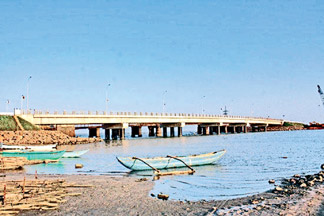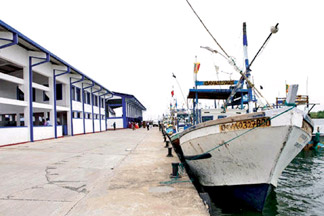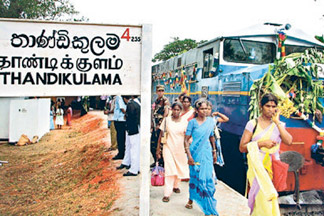|
North records highest growth rate of 27.1%:
Development drive focuses on provinces
By Shirajiv SIRIMANE
|

Mannar bridge |
One of the key elements that led to the youth insurrections in 1971
and 1988/89 and the birth of the LTTE was the minimum focus paid by
authorities to development in the provinces. Thus, a common slogan used
to woo youth to take up arms was Kolambata Kiri Apita Kekiri which meant
that all resources were based around the Western Province. Central Bank
data too supported this theory as the per capita income and GDP of the
Western Province was far higher than those of the other provinces.
President Mahinda Rajapaksa, hailing from the South, too experienced
this trend and hence, one of his priorities was to develop the rural
provinces and increase the money flow to these forgotten areas. One of
the top and most successful initiatives taken in this regard was the
Gamata Karmantha drive which provided attractive incentives to
entrepreneurs who chose to start up businesses in rural areas.
This was a successful initiative and several leading companies have
taken advantage of this and started factories providing numerous
benefits for rural youth. Though Hambantota did not experience terrorism
problems, like in the North and the East, the area was highly neglected
and ignored by successive governments. Today, however it is being
developed at a rapid pace.
Similarly, the North and the East too are being developed with
billions of rupees being pumped in, to provide the much needed
infrastructure and to bring its standards in line with those of other
districts.
|

Valaichchenai fisheries Harbour in Batticaloa |
One of the priorities in Hambantota and the North and East
development is to provide a good road network. Currently, the highway is
being extended to Hambantota and Arugam Bay while the Northern highway
too is falling into place. The rail track too is being redeveloped. The
final phase of construction of the 10-km long railway track, stretching
from Thandikulam to Omanthai, is nearing completion.
The track is being laid with the active support of the 5th Field
Engineer Regiment Corps of the Sri Lanka Army. The Army engineers
supported the Government’s ongoing reconstruction of the Northern-bound
railway line and responded positively to the challenge. Construction
work on the Nochchimotte bridge, the second largest bridge along the
Northern railway line, between Thandikulam to Kankesanthurai, has been
completed. The bridge between Thandikulam and Omanthai railway stations
was destroyed by the LTTE during the war against terrorism.

Tourists at Arugam Bay |
 |
| The Yal Devi
at Thandikulam |
The construction of the Talaimannar-Medawachchiya railway line is in
rapid progress and is due to be opened by late 2013, Mannar District
Secretary Sarath Ravindra said.
Railway track
The Transport Ministry has also inked an agreement with IRCON
International Limited, an Indian government company, for the
reconstruction of the railway track from Omanthai to Pallai. The
Government will launch two new rail-bus services, between Gal Oya and
Trincomalee and Gal Oya and Batticaloa, in the Eastern Province under
the Negenahira Navodaya program in a bid to provide free movement of
goods to these areas.
Several projects funded by the Asian Development Bank, through the
North East Coastal Community Project are making headway improving the
living standards of the population of the Eastern Province especially in
the Trincomalee district.
The Cod Bay Fisheries Harbour project in China Bay is one such
project under which mangroves are being re-established to enhance prawn,
crab and lobster stock. The project is envisaged to enhance existing
berthing capacity for ocean-going vessels, venturing into fringe waters
bordering Sri Lankan nautical limits. The project is expected to be
completed next month.
The Economic Development Ministry had invested Rs. 1,768.6 million in
development projects in the Ampara district last year. The Government
has spent Rs. 54,837 million during the past five years to develop the
agriculture sector and fisheries industry and to provide infrastructure
facilities in the Batticaloa district.
The Government has also taken steps towards a massive agricultural
development drive in the Mannar district. The Ministry of Economic
Development has spent Rs. 33,025 million on its provincial development
projects implemented with foreign assistance.
There are eight large scale foreign-funded projects implemented by
the Ministry of Economic Development in the North, the East and other
provinces.
The new Mannar bridge and causeway, connecting the Mannar island with
the mainland, was constructed at a cost of Rs. 2,460 million.
In the Kilinochchi district, 8,000 acres of land in the Iranamadu
area has been earmarked for the Air Force base, including for the
building of an international airport, in the third stage of its
development. Phase one of the project covers site clearance and
building, administrative, recreational, residential and administrative
complexes, which are being carried out at an estimated cost of Rs. 70
million. The base will be commissioned before the end of this year.
Tenders are being called to develop Kuchchaveli, in the Trincomalee
district, as a tourism base. Three investors have already expressed
interest on marine development in the Kuchchaveli area.
Tourism development
A stretch of land, eight kilometres long with an extent of 600 acres,
has been identified for tourism development in Kuchchaveli. A Tourism
Development Action Plan for the Eastern Province has been implemented by
the Tourism Ministry, aiming to boost tourism in the province. This
Action Plan has been signed by a three-member committee of the Sri Lanka
Tourism . The Tourism Ministry will take steps to organise 24 projects
in the Action Plan into operation.
These initiatives have helped breach the regional disparity gap.
Continuing the trend observed in the recent past, the share of the
Western Province in the GDP declined further in 2011, reducing
disparities between the provinces.
However, Provincial Gross Domestic Product (PGDP) for the Western
Province grew at a healthy rate of 15.6 percent, largely underpinned by
the expansion in manufacturing and trade.
The Northern Province recorded the highest nominal growth rate and
increased its contribution to the national economy, driven by an
expansion in agriculture, fishing, construction, transportation and
financial services. The North Western and Southern Provinces had the
next highest growth rates and also increased their share of the GDP.
These two provinces benefited from greater contributions from trade,
manufacturing, financial services and transport while the Southern
Province benefited largely from the high growth momentum in the
construction sector. The nominal growth rates in the Eastern and North
Central Provinces moderated and recorded a decline in their shares of
the GDP, due to a setback in the agriculture sector as a consequence of
adverse weather conditions that prevailed in the first quarter of 2011.
The nominal growth of the Central Province GDP also decelerated and
its share to the national GDP declined, with the drop in hydro power
generation in the second half of 2011.
All provinces recorded double digit nominal growth rates in their
PGDP in 2011. The Northern Province recorded the highest growth rate of
27.1 percent, in nominal terms, in 2011. The PGDPs of the North Western
and Southern Provinces grew by 21.9 percent and 21.4 percent
respectively. However, the growth rates of the Eastern, North Central,
Central and Sabaragamuwa Provinces decelerated in 2011 compared to 2010.
The main reason for the high growth in the Northern province was the
improved performance in the agriculture sector. The paddy production of
the Northern Province increased by 90 percent to 210 million kilograms
in 2011 compared to 2010. Significant increases in both inland and
marine fish production in the Northern Province also contributed to this
high growth in 2011. The marine and inland fish production of the
Northern Province increased by 38 percent and 165 percent to 46,370 and
2,150 metric tons respectively in 2011.
The high growth witnessed in the Northern Province was also supported
by the expansion of banking services, with 34 new branches established
in 2011.
Infrastructure development
The increased economic activities due to major infrastructure
development projects including the Southern Expressway, Mattala airport
and Hambantota port, as well as better performance in the tourism sector
contributed largely to the high growth of 21.4 percent in the Southern
Province’s GDP.
Noticeable growth in the manufacturing and financial sectors helped
the North Western Province to record 21.9 percent growth in its GDP in
2011. Meanwhile, the Eastern, North Central, Central and Sabaragamuwa
Provinces showed a marginal deceleration in their growth rates in 2011.
Adverse weather conditions that prevailed during the first quarter of
2011, affected the performance in the agriculture sector in both the
Eastern and North Central Provinces. Paddy production in the Eastern and
North Central Provinces decreased by 39 percent and three percent to 650
and 1,144 million kilograms respectively in 2011. In addition, vegetable
production in both Eastern and North Central Provinces dropped by 33
percent and seven percent respectively while highland crop production of
the Eastern and North Central Provinces decreased by 12 percent and 33
percent respectively in 2011.
Setbacks observed in hydropower generation in the second half of 2011
affected the performance of the Central Province. Hydropower generated
from the major power stations in the Central Province dropped by 21
percent to 3,350 GWh in 2011, reducing the value addition in the
manufacturing sector of the province.
[Share of provincial GDP in overall GDP]
Reflecting high growth performances in other provinces, the share of
the Western Province to the overall GDP declined to 44.4 percent in 2011
from 44.8 percent in 2010.
The Southern Province accounted for the second highest contribution
of 11.1 percent in 2011, compared to 10.7 percent in 2010. The third
highest contribution to the country’s GDP came from the North Western
Province, which was 10 percent in 2011 compared to 9.5 percent in the
previous year.
The contribution of the Northern Province to GDP increased to 3.7
percent in 2011 from 3.4 percent in 2010. However, the shares of the
Central, Eastern, North Central and Sabaragamuwa Provinces declined to
9.8 percent, 5.7 percent, 4.6 percent and 6.2 percent, respectively, in
2011. The contribution of the Uva Province remained unchanged during the
year.
[Provincial Per Capita Income]
The per capita of all provinces increased in 2011. The per capita
income of the Western Province at Rs. 490,724 was 1.6 times the national
per capita income in 2011. The per capita income in all other provinces
remained below the national average of Rs. 313,511.
[Contributions to PGDP]
There were considerable variations in the structure of the PGDP
across the provinces. The agriculture sector accounted for around three
percent of the GDP in the Western Province in 2011, whereas it accounted
for 15 - 30 percent of the GDP in the other provinces.
The contribution of the agriculture sector to the PGDP decreased in
all provinces in 2011, except in the Western and Northern Provinces. The
industry sector’s contribution to PGDP increased in 2011 in all
provinces, except for the Central and North Western Provinces.
As in 2010, the largest contribution to PGDP from the industry sector
was observed in the Southern Province.
The services sector was the most dominant sector, accounting for
between 49.6 percent and 64.1 percent of the PGDP in different
provinces. The contribution from the services sector declined in the
Western and Northern Provinces, but increased in all other provinces
during 2011. |

